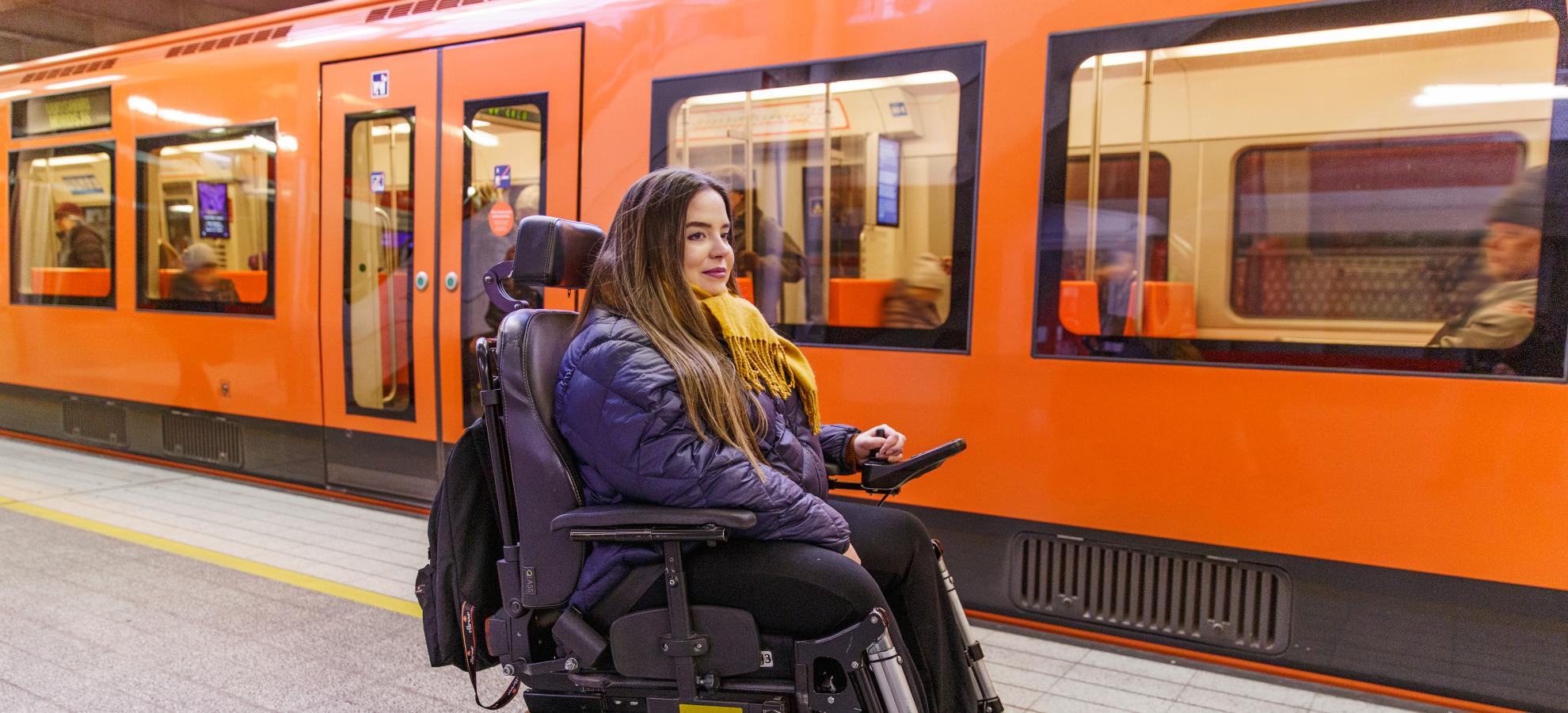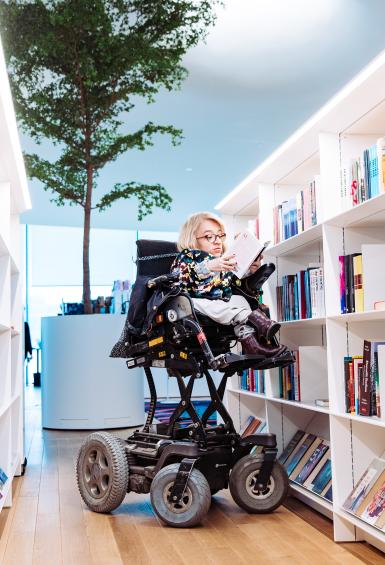
The centre of Helsinki is very compact, making it easy for people with disabilities to get around using mobility aids. Accessibility has been a priority for the City of Helsinki, for example in planning smooth and obstruction-free pedestrian crossings, sidewalks and roads.

The 1.3-kilometre pedestrian and bicycle corridor Baana is fully accessible for mobility aids and offers a fun way of getting all the way from the Museum of Contemporary Art Kiasma in the city centre to the district of Ruoholahti, where you continue onwards to the West Harbour (Länsisatama) and Hernesaari. In the historical quarters, such as between the Market Square and Senate Square, there are still lots of cobblestone streets which can impede mobility for people with disabilities and visual impairments.
Audio cues and crossing signals are not yet widely used in Helsinki, so people with visual impairments should take extra care when crossing busy streets in particular, such as Mannerheimintie, and around the Market Square, which is crisscrossed by many small streets and tram tracks. The seasons also create certain challenges for accessibility, and getting around town with mobility aids is often much easier in spring, summer or autumn than it is in winter, when the streets are usually covered by snow and ice. The main shopping street, Aleksanterinkatu, is actually heated, however, making it accessible throughout the year.

Public transport network
Helsinki has a diverse public transport network with a wide range of accessible modes of transport. Passengers traveling with a manual or electric wheelchair can travel free of charge and without a ticket on Helsinki Region Transport (HSL) vehicles (commuter trains, metro, trams, local buses, Suomenlinna municipal ferry) regardless of whether they are visitors or locals. However, the traveller's possible escort must have a valid ticket. A person who needs an escort permanently living in the HSL area can apply for a card that also entitles the escort to travel free of charge. You can take a mobility scooter with separate handlebar to the metro and the Suomenlinna ferry, but it cannot be brought on the bus or tram, as they do not fit in the space designed for wheelchairs in transport. A mobility scooter may board a train if it is used by a person with reduced mobility who uses it as an assistive device.
People with visual impairments can travel most conveniently in Helsinki by tram or commuter trains, as their timetables are available in accessible format, they operate regularly, and the stops are announced to passengers. Buses are more challenging, as getting on the right bus or getting off at the right stop can be tricky, and their timetables are harder to find in accessible format. All buses in the HSL area also have announcements stating the name of the stop. People with hearing impairments benefit from text displays at stations and vehicles. There is no induction loop in the vehicles. Read more HSL website.
What I love about Helsinki especially is its compact size – that I can drive my electric wheelchair all the way from the shoreline to the city centre. Summer is my time of year, because that’s when it’s easiest to get around. When I’m travelling by myself on public transport, I prefer to go by metro or commuter train, as I can use them completely independently. I also fit in them easiest. Buses and trams have less space and you have to reserve more time, as the space that is available on them can be full of strollers already when they arrive at your stop.

Trains
Commuter trains are a fast and convenient way to and from Helsinki Airport, for example. The journey between the city centre and the airport takes around 30 minutes. Train carriages with services for the disabled are marked by the international wheelchair symbol. The same symbol can be found on the button that activates a ramp to get you across the gap safely. All stations in Helsinki and at the airport have raised platforms that are at the same level as the doors, although there can still be slight height differences, especially if the platform is covered by snow. Commuter trains also get you to the neighbouring municipalities of Espoo and Vantaa. Announcements are made onboard, and there are also displays. The Junat.net website serves as a live departure board with real-time timetables for all Finnish train stations. The website is also accessible for people with visual impairments, making it especially convenient if you can’t see the departure board at the station. Other parts of Finland can be reached by long-distance trains, which are also fully accessible. Further information about accessibility on trains is available on the VR website.
Metro
The metro is a very accessible mode of transport in Helsinki. The metro extends to the east and west of the city. All metro stations are fully accessible, and the platforms are at the same height as the carriage doors, making it easy to board with mobility aids. Announcements are made onboard, and there are also displays. Announcements are generally not made inside stations, but the destination of each metro can be seen on the display above the platform and on the front of the metro.
Trams
Trams are a convenient way of getting around the city centre and between the centre and the West Harbour, for example. There are several different types of tram carriages in service, but they all have low floors in one or more carriages. The height of tram platforms varies, so there can be a significant height difference or gap between the platform and the door. Most trams have a ramp in the middle doors. These ramps are manually operated and locked in place. By pressing the ramp button, the driver will unlock the ramp and help open it, if assistance is required. Mobility scooters cannot be taken on trams. Announcements are made on board, and there are also displays.

Suomenlinna ferry
Ferries operate all year round between the mainland and the Suomenlinna Sea Fortress, and the crossing takes just over a quarter of an hour. The most accessible option is the HSL municipal ferry, which departs from the Market Square. Passengers with mobility aids can sit inside the ferry or enjoy the scenery from the lower deck. Suomenlinna itself can be challenging in places for persons with restricted mobility or visual impairments due to the uneven surfaces. Some of the paths on the islands are accessible, however, and more information about accessibility is available on the Suomenlinna website.
Buses
All buses in Helsinki have low floors and a manual ramp in the middle doors that comes out of the floor. The driver will provide assistance with the ramp if required. Mobility scooters cannot be taken on buses. All buses have stop name announcements. People with hearing impairments benefit from text displays at stations and vehicles. There is no induction loop in the vehicles.
Taxis
A wide range of taxis operate in Helsinki, and it is easy to find taxis for the disabled that are accessible with a lift or ramp. Taxis for the disabled should be ordered in advance to avoid having to wait, but they can also be found occasionally at taxi stands. Taxis can be ordered by phone from Taksi Helsinki (t. 0100 0700) or Lähitaksi (t. 0100 7300), for example. Be sure to mention any mobility aids that need to be transported and other special needs. Taxis for the disabled are often entitled to charge an assistance surcharge, increasing the total price of the journey.




